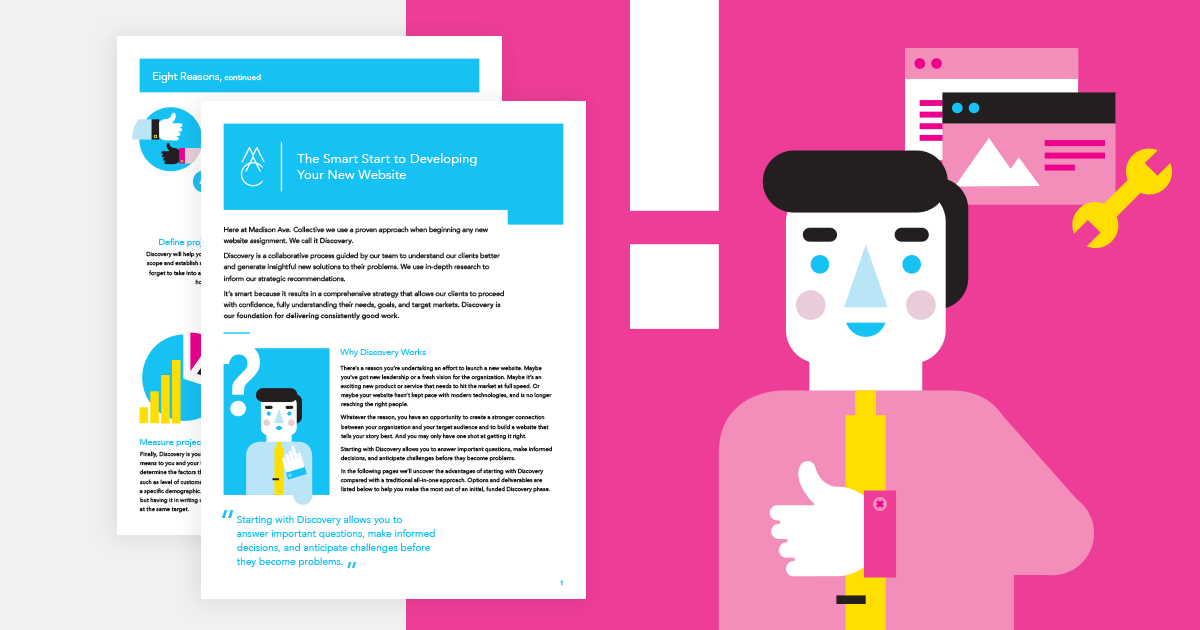
How to build a higher ed website that achieves excellence
It’s one thing to deliver an excellent student experience on campus; quite another to build an excellent website. Between us and one of our long-term clients, Colleges of Distinction, we’ve evaluated a countless number of college and university websites — the good, the bad, and everything in between.
In this article we’d like to share some of what we’ve learned, so that you can help your own higher ed website achieve excellence.
Got challenges? You’re not alone
Let’s start with some of the most common issues we’ve seen in higher ed websites. Does any of this sound familiar?
No message. Many higher ed websites lack a strong brand story. Also, they’re not sending targeted messages to defined audiences, prompting them to take specific actions.
No differentiation. What makes you different from other colleges and universities? Whether or not you can articulate it internally, we’ve noticed many schools aren’t communicating it clearly online.
Internal focus. It’s easy to get so absorbed in the internal workings of your administration, faculty, and staff that you lose sight of what new students or donors need from your website.
Lots of sub-brands. Do you have a different microsite for each department? The ensuing chaos makes brand consistency a far-off dream — and maintaining the various logos, page templates, and back-end technologies is hard work. More importantly, an inconsistent experience for prospective students, donors, and other users can be jarring and off-putting.
Content clutter. Is your website a recruitment tool? an enrollment driver? a resource for students and faculty? … or is it a repository of all the information you’ve ever used, most of it out of date?
Best practices, to the rescue!
For every challenge, there’s a best practice to resolve it. Let’s look at a few of the most helpful rules we’ve noted from our experience.
Think strategically. A strategy is four things: a problem, a goal, a plan, and a result. Where is your website falling short? Where do you want it to be? Answer that, and you can plan a path to action.
Think like a user. Is the hierarchy of info logical? Are pages organized to meet the user’s most pressing needs first? Have you mapped the paths that users take and built a coherent journey for students?
Make action easy. Every call to action should be clear and convincing, and the conversion points — the places where users take those actions —should be easy to find and respond to.
Cross all those Ts. Every area of your website should be an extension of your brand. The design should be mobile-responsive, accessible from any device. It also needs to be compliant with WCAG accessibility rules.
Establish metrics. Without a way to measure success, who’s to say if your efforts are paying off? We know it can be tricky to identify objective markers — but it can be done, and it’s essential.
Move forward the smart way
When it comes to choosing an agency, there are two options: the conventional route, and the streamlined route.
The conventional route goes like this. You write a lengthy, time-consuming RFP, and post it publicly to invite responses from all corners of the country. The RFP (request for proposal) may or may not provide candidates with the type or quality of information they need to write a meaningful proposal, resulting in hundreds of written pages based on their best guesswork, which your selection committee takes weeks to carefully comb through. After holding a series of interviews, you make a choice, and at last your new creative partner starts work. The process was costly, imprecise, and effort-intensive — and hey, it only took six months to get to the starting line.
The streamlined route works through relationship-building, and as such, it’s much more targeted and timely. You develop a list of parameters you want your partner agency to match (specific areas of expertise, years of experience, etc.), seek referrals, and do some research on your own. You then put out an RFQ (request for quotation), which is shorter and easier to evaluate than RFPs to a limited pool of pre-qualified or pre-selected firms. Once you have narrowed your list of candidates based on the RFQ responses, you pick up the phone or meet in person to discuss what you hope to achieve. The information and insights that emerge from these conversations are more likely to fit your needs and propel you forward. At the end of the day, you’re launching your new website much sooner — and spending less money and energy—than with the traditional RFP process.
How to choose the right partner?
Scan for strategy. Many creative professionals make beautiful work — but the point isn’t just to look pretty. It’s to accomplish the goals of your organization and meet the needs of your stakeholders. How do your candidates propose to do so? Do they have a proven process for delivering results?
Invest in discovery. Your agency partner should talk with your internal and external stakeholders, perform a brand audit and competitive analysis, and research your history, values, goals, and competitors. Up-front research is the necessary foundation for getting started and will guide decision-making throughout the project.
Avoid death by committee. When collecting initial input, ask everyone. Make sure key stakeholders and representatives from every target audience have an opportunity to be heard. But when making decisions, establish a small, tight-knit team with the judgement to weigh conflicting perspectives and make the call.
Be bold. Today’s degree-seekers aren’t looking for the same old / same old. Don’t be afraid to look and sound different. We know standing out can be scary — but when you do, great things can happen.
The tips above may seem simple, but make no mistake: they’re game changers. After researching and auditing countless higher ed websites, we’ve seen these principles bear out over long and close observation. We hope they help you achieve excellence in your website, too.
This article is also published on Medium.
More Resources
-

Article
A better way to brand and market online degreesUniversities coast-to-coast are offering an ever-increasing number of degrees and certificates online these days (craft brewing or turf grass management,...
-

Article
Taglines, slogans, and other messaging: New rules for differentiation in higher edMore than just words Whether it’s a tagline or a slogan, a motto, or a mantra, the rules are the...
-

eBook
The Smart Start to Developing Your New WebsiteAll website development projects start with questions. Lots of questions. In order to uncover unknowns and proceed with confidence, we...



